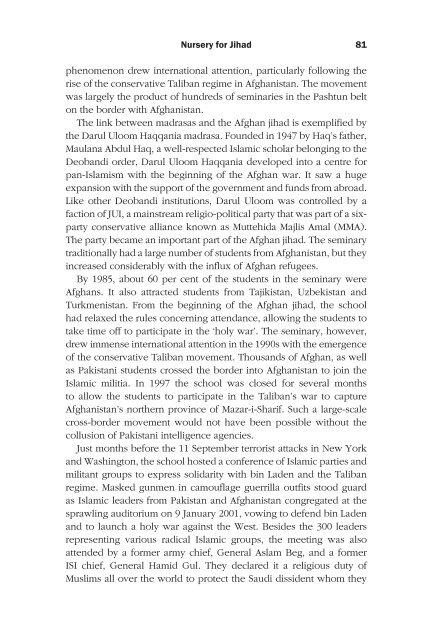Frontline Pakistan : The Struggle With Militant Islam - Arz-e-Pak
Frontline Pakistan : The Struggle With Militant Islam - Arz-e-Pak
Frontline Pakistan : The Struggle With Militant Islam - Arz-e-Pak
You also want an ePaper? Increase the reach of your titles
YUMPU automatically turns print PDFs into web optimized ePapers that Google loves.
Nursery for Jihad<br />
phenomenon drew international attention, particularly following the<br />
rise of the conservative Taliban regime in Afghanistan. <strong>The</strong> movement<br />
was largely the product of hundreds of seminaries in the Pashtun belt<br />
on the border with Afghanistan.<br />
<strong>The</strong> link between madrasas and the Afghan jihad is exemplified by<br />
the Darul Uloom Haqqania madrasa. Founded in 1947 by Haq’s father,<br />
Maulana Abdul Haq, a well-respected <strong>Islam</strong>ic scholar belonging to the<br />
Deobandi order, Darul Uloom Haqqania developed into a centre for<br />
pan-<strong>Islam</strong>ism with the beginning of the Afghan war. It saw a huge<br />
expansion with the support of the government and funds from abroad.<br />
Like other Deobandi institutions, Darul Uloom was controlled by a<br />
faction of JUI, a mainstream religio-political party that was part of a sixparty<br />
conservative alliance known as Muttehida Majlis Amal (MMA).<br />
<strong>The</strong> party became an important part of the Afghan jihad. <strong>The</strong> seminary<br />
traditionally had a large number of students from Afghanistan, but they<br />
increased considerably with the influx of Afghan refugees.<br />
By 1985, about 60 per cent of the students in the seminary were<br />
Afghans. It also attracted students from Tajikistan, Uzbekistan and<br />
Turkmenistan. From the beginning of the Afghan jihad, the school<br />
had relaxed the rules concerning attendance, allowing the students to<br />
take time off to participate in the ‘holy war’. <strong>The</strong> seminary, however,<br />
drew immense international attention in the 1990s with the emergence<br />
of the conservative Taliban movement. Thousands of Afghan, as well<br />
as <strong><strong>Pak</strong>istan</strong>i students crossed the border into Afghanistan to join the<br />
<strong>Islam</strong>ic militia. In 1997 the school was closed for several months<br />
to allow the students to participate in the Taliban’s war to capture<br />
Afghanistan’s northern province of Mazar-i-Sharif. Such a large-scale<br />
cross-border movement would not have been possible without the<br />
collusion of <strong><strong>Pak</strong>istan</strong>i intelligence agencies.<br />
Just months before the 11 September terrorist attacks in New York<br />
and Washington, the school hosted a conference of <strong>Islam</strong>ic parties and<br />
militant groups to express solidarity with bin Laden and the Taliban<br />
regime. Masked gunmen in camouflage guerrilla outfits stood guard<br />
as <strong>Islam</strong>ic leaders from <strong><strong>Pak</strong>istan</strong> and Afghanistan congregated at the<br />
sprawling auditorium on 9 January 2001, vowing to defend bin Laden<br />
and to launch a holy war against the West. Besides the 300 leaders<br />
representing various radical <strong>Islam</strong>ic groups, the meeting was also<br />
attended by a former army chief, General Aslam Beg, and a former<br />
ISI chief, General Hamid Gul. <strong>The</strong>y declared it a religious duty of<br />
Muslims all over the world to protect the Saudi dissident whom they<br />
1













